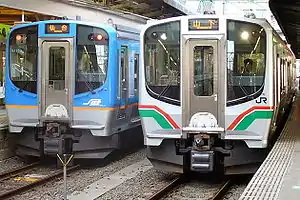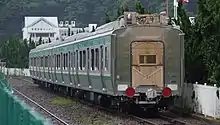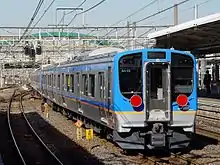E721 series
The E721 series (E721系) is an electric multiple unit (EMU) train type operated by East Japan Railway Company (JR East) on services in the Sendai area of Japan since February 2007.
| E721 / SAT721 / AB900 series | |
|---|---|
 E721-0 series (right) and SAT721 series (left), August 2007 | |
| Manufacturer | Kawasaki Heavy Industries, Tokyu Car Corporation, J-TREC (Niitsu and Yokohama) |
| Replaced | 455 series, 417 series, 717 series, 719 series |
| Constructed | 2006–2017 |
| Entered service | February 2007 |
| Number under construction | 36 vehicles (9 sets) |
| Number built | 142 vehicles (61 sets) |
| Number in service | 138 vehicles (59 sets) |
| Number scrapped | 4 vehicles (2 sets, tsunami damage) |
| Formation | 2/4 cars per set |
| Fleet numbers | P1–P44, P501–P504, P4-1–P4-19, SA101–SA103 |
| Operator(s) | JR East Sendai Airport Transit (SAT721) Abukuma Express (AB900) |
| Depot(s) | Sendai |
| Line(s) served |
|
| Specifications | |
| Car body construction | Stainless steel |
| Car length | 20,000 mm (65 ft 7 in) |
| Width | 2,950 mm (9 ft 8 in) |
| Floor height | 950 mm (3 ft 1 in) |
| Doors | 3 pairs per side |
| Maximum speed | 120 km/h (75 mph) |
| Power output | 500 kW per motor |
| Electric system(s) | 20 kV AC (50 Hz) overhead catenary |
| Current collection method | Pantograph |
| Bogies | DT72 (motored), TR256 (trailer) |
| Safety system(s) | ATS-Ps |
| Multiple working | 701 series |
| Track gauge | 1,067 mm (3 ft 6 in) |
Variants
- E721-0 series 2-car sets, since February 2007
- E721-500 series 2-car sets, since March 2007
- E721-1000 series 4-car sets, since November 2016
- SAT721 series 2-car sets, since March 2007 (owned by Sendai Airport Transit)
- AB900 series 2-car sets, since July 2019
 E721-0 series set P-4 in March 2007
E721-0 series set P-4 in March 2007 E721-500 series set P-502 in November 2007
E721-500 series set P-502 in November 2007 E721-1000 series set P4-14 in January 2017
E721-1000 series set P4-14 in January 2017 SAT721 series set SA102 in March 2008
SAT721 series set SA102 in March 2008 AB900 series set AB-1 on delivery at Zushi Station in February 2019
AB900 series set AB-1 on delivery at Zushi Station in February 2019
Operations
- ■ Banetsu West Line (since March 2017)[1]
- ■ Joban Line
- ■ Senzan Line
- ■ Sendai Airport Line (E721-500 series and SAT721 series only)
- ■ Tohoku Main Line
- ■ Abukuma Express Line (AB900 series)
Formations
As of 1 October 2015, the fleet consists of 42 two-car E721-0 series sets (P-2 to P-44), four E721-500 series two-car sets (P-501 to P-504), and three SAT721 series two-car sets (SA101 to SA103), formed as follows with one motored (Mc) and one trailer (Tc') car.[2]
E721-0 series
| Designation | Mc | Tc' |
|---|---|---|
| Numbering | KuMoHa E721-xx | KuHa E720-xx |
The KuMoHa cars have one PS109 single-arm pantograph. The KuHa cars have a toilet.[2]
E721-500 series
| Designation | Mc | Tc' |
|---|---|---|
| Numbering | KuMoHa E721-50x | KuHa E720-50x |
The KuMoHa cars have one PS109 single-arm pantograph. The KuHa cars have a toilet.[2]
E721-1000 series
The 19 four-car E721-1000 series sets (P4-1 to P4-19) are formed as follows, with two motored ("M") cars and two non-powered trailer ("T") cars.[3] The KuHa E720 is located at the southern end.[3]
| Designation | Tc' | M | T | Mc |
|---|---|---|---|---|
| Numbering | KuHa E720-10xx | MoHa E721-10xx | SaHa E721-10xx | KuMoHa E7210-10xx |
| Weight (t) | 34.3 | 32.0 | 37.2 | 39.1 |
| Capacity (seated/total) | 50/132 | 62/152 | 62/152 | 56/138 |
The two motored cars (KuMoHa and MoHa) each have one PS109 single-arm pantograph.[3] The KuHa cars have a toilet.[3]
 The interior of car KuMoHa E721-1005 of set P4-5 in January 2017
The interior of car KuMoHa E721-1005 of set P4-5 in January 2017 An LED passenger information panel above the doorway in car KuMoHa E721-1005 of set P4-5 in January 2017
An LED passenger information panel above the doorway in car KuMoHa E721-1005 of set P4-5 in January 2017
SAT721 series
The two-car SAT721 series sets are formed as follows.
| Designation | Mc | Tc' |
|---|---|---|
| Numbering | SAT721-10x | SAT720-10x |
The KuMoHa cars have one PS109 single-arm pantograph. The KuHa cars have a toilet.[2]
 The interior of car SAT721-101 in April 2017
The interior of car SAT721-101 in April 2017 Priority seating and luggage space in car SAT721-101 in April 2017
Priority seating and luggage space in car SAT721-101 in April 2017
History
The first E721-0 series sets were delivered from December 2006, and entered service on 1 February 2007 on Tohoku Main Line services.[2] The first E721-500 and SAT721 series sets were delivered from February 2006 and entered service on Sendai Airport services on 18 March 2007.[2]
Two sets, P-1 and P-19, were derailed and badly damaged by the 2011 Tōhoku earthquake and tsunami on 11 March 2011 while at Shinchi Station, and were withdrawn.[2]
 The remains of sets P-1 and P-19 at Shinchi Station after the tsunami in 2011
The remains of sets P-1 and P-19 at Shinchi Station after the tsunami in 2011

The first of a fleet of 19 new four-car E721-1000 sets (76 vehicles in total) was introduced on 30 November 2016[6] on Tohoku Main Line, Joban Line, and Senzan Line services, replacing older 719 series units.[7] The new trains are built by J-TREC, with construction shared between the company's Yokohama and Niitsu factories.[7] These trains feature LED interior lighting.[7]
The first four E721-1000 series intermediate cars were delivered from J-TREC's Niitsu factory to its Yokohama factory in September 2016 to be combined with driving cars built there.[8]
In order to replace their 8100 series trains, Abukuma Express announced the order of new AB900 series trains in summer 2018.[4] They are based on the E721 series,[9] and are the first new trains for Abukuma Express since 1988.[10] The first AB900 series set was delivered in February 2019.[4] It entered service on 1 July 2019.[10]
Fleet/build details
The manufacturers and delivery dates for the fleet are as shown below.[2]
E721-0 series
| Set No. | Manufacturer | Date delivered | Date withdrawn |
|---|---|---|---|
| P-1 | Kawasaki Heavy Industries | 28 November 2006[11] | 12 March 2011[Note 1] |
| P-2 | Kawasaki Heavy Industries | 17 January 2007 | |
| P-3 | Kawasaki Heavy Industries | 17 January 2007 | |
| P-4 | Kawasaki Heavy Industries | 17 January 2007 | |
| P-5 | Tokyu Car | 18 December 2006 | |
| P-6 | Tokyu Car | 18 December 2006 | |
| P-7 | Kawasaki Heavy Industries | 15 January 2007 | |
| P-8 | Kawasaki Heavy Industries | 6 February 2007 | |
| P-9 | Kawasaki Heavy Industries | 6 February 2007 | |
| P-10 | Kawasaki Heavy Industries | 23 February 2007 | |
| P-11 | Kawasaki Heavy Industries | 23 February 2007 | |
| P-12 | Tokyu Car | 15 January 2007 | |
| P-13 | Tokyu Car | 15 January 2007 | |
| P-14 | Kawasaki Heavy Industries | 28 February 2007 | |
| P-15 | Kawasaki Heavy Industries | 28 February 2007 | |
| P-16 | Kawasaki Heavy Industries | 8 March 2007 | |
| P-17 | Kawasaki Heavy Industries | 8 March 2007 | |
| P-18 | Kawasaki Heavy Industries | 23 March 2007 | |
| P-19 | Kawasaki Heavy Industries | 23 March 2007[11] | 12 March 2011[Note 1] |
| P-20 | Kawasaki Heavy Industries | 23 March 2007 | |
| P-21 | Kawasaki Heavy Industries | 23 March 2007 | |
| P-22 | Kawasaki Heavy Industries | 17 April 2007 | |
| P-23 | Kawasaki Heavy Industries | 17 April 2007 | |
| P-24 | Kawasaki Heavy Industries | 27 April 2007 | |
| P-25 | Kawasaki Heavy Industries | 27 April 2007 | |
| P-26 | Kawasaki Heavy Industries | 27 April 2007 | |
| P-27 | Kawasaki Heavy Industries | 27 April 2007 | |
| P-28 | Kawasaki Heavy Industries | 31 May 2007 | |
| P-29 | Kawasaki Heavy Industries | 31 May 2007 | |
| P-30 | Kawasaki Heavy Industries | 31 May 2007 | |
| P-31 | Kawasaki Heavy Industries | 31 May 2007 | |
| P-32 | Kawasaki Heavy Industries | 6 July 2007 | |
| P-33 | Kawasaki Heavy Industries | 6 July 2007 | |
| P-34 | Tokyu Car | 30 August 2007 | |
| P-35 | Tokyu Car | 30 August 2007 | |
| P-36 | Tokyu Car | 26 September 2007 | |
| P-37 | Tokyu Car | 26 September 2007 | |
| P-38 | Kawasaki Heavy Industries | 2 November 2007 | |
| P-39 | Kawasaki Heavy Industries | 2 November 2007 | |
| P-40 | Kawasaki Heavy Industries | 13 September 2010 | |
| P-41 | Kawasaki Heavy Industries | 13 September 2010 | |
| P-42 | Kawasaki Heavy Industries | 13 September 2010 | |
| P-43 | Kawasaki Heavy Industries | 14 September 2010 | |
| P-44 | Kawasaki Heavy Industries | 14 September 2010 |
- Destroyed by tsunami on 11 March 2011.
E721-500 series
| Set No. | Manufacturer | Date delivered | Date withdrawn |
|---|---|---|---|
| P-501 | Kawasaki Heavy Industries | 17 February 2006 | |
| P-502 | Kawasaki Heavy Industries | 30 September 2006 | |
| P-503 | Kawasaki Heavy Industries | 30 September 2006 | |
| P-504 | Tokyu Car | 25 October 2006 |
E721-1000 series
| Set No. | Manufacturer | Date delivered | Date withdrawn |
|---|---|---|---|
| P4-1 | J-TREC | 21 October 2016[12] | |
| P4-2 | J-TREC | 26 October 2016[12] | |
| P4-3 | J-TREC | 11 November 2016[12] | |
| P4-4 | J-TREC | 16 November 2016[12] | |
| P4-5 | J-TREC | 28 November 2016[12] | |
| P4-6 | J-TREC | 1 December 2016[12] | |
| P4-7 | J-TREC | 6 December 2016[12] | |
| P4-8 | J-TREC | 14 December 2016[12] | |
| P4-9 | J-TREC | 27 December 2016[12] | |
| P4-10 | J-TREC | 26 December 2016[12] | |
| P4-11 | J-TREC | ||
| P4-12 | J-TREC | ||
| P4-13 | J-TREC | ||
| P4-14 | J-TREC | ||
| P4-15 | J-TREC | ||
| P4-16 | J-TREC | ||
| P4-17 | J-TREC | ||
| P4-18 | J-TREC | ||
| P4-19 | J-TREC |
SAT721 series

| Set No. | Manufacturer | Date delivered | Date withdrawn |
|---|---|---|---|
| SA101 | Kawasaki Heavy Industries | 20 November 2006 | |
| SA102 | Kawasaki Heavy Industries | 20 November 2006 | |
| SA103 | Kawasaki Heavy Industries | 20 November 2006 |
See also
- Aoimori 703 series, a derivative for use on the Aoimori Railway
References
- 磐越西線でE721系の運転開始 [E721 series enter service on the Banetsu West Line]. Japan Railfan Magazine Online (in Japanese). Japan: Koyusha Co., Ltd. 9 March 2017. Archived from the original on 9 March 2017. Retrieved 9 March 2017.
- JR電車編成表 2016冬 [JR EMU Formations – Winter 2016] (in Japanese). Japan: Kotsu Shimbunsha. 18 November 2015. p. 28–29. ISBN 978-4-330-62315-3.
- One, Akihiro (February 2017). E721系1000番台 [E721-1000 series]. Japan Railfan Magazine (in Japanese). Vol. 57 no. 670. Japan: Koyusha Co., Ltd. p. 50–53.
- "阿武隈急行AB900系が登場" [Abukuma Express AB900 series appeared]. Japan Railfan Magazine Online (in Japanese). Japan: Koyusha Co., Ltd. 21 February 2019. Archived from the original on 11 August 2019. Retrieved 11 August 2019.
- "【JR貨】【阿武隈急行】AB900系第2編成を甲種輸送" [(JR freight) (Abukuma Express) Transport of the second AB900 series set]. rail.hobidas.com (in Japanese). Neko Publishing. 20 February 2020. Archived from the original on 21 February 2020. Retrieved 21 February 2020.
- E721系1000番台が営業運転を開始 [E721-1000 series enters revenue service]. Japan Railfan Magazine Online (in Japanese). Japan: Koyusha Co., Ltd. 9 December 2016. Archived from the original on 4 January 2017. Retrieved 4 January 2017.
- E721系1000 代新造車両の投入について [Details of introduction of new E721-1000 series trains] (PDF). News release (in Japanese). Japan: East Japan Railway Company Sendai Division. 26 May 2016. Retrieved 27 May 2016.
- E721系1000番台中間車が甲種輸送される [E721-1000 series intermediate cars transported]. Japan Railfan Magazine Online (in Japanese). Japan: Koyusha Co., Ltd. 23 September 2016. Archived from the original on 23 September 2016. Retrieved 23 September 2016.
- "阿武隈急行の新型車両AB900系電車が完成 JR貨物の「金太郎」にけん引されて福島へ" [Abukuma Express' new vehicle, the AB900 series train, is completed. Towed by JR Freight “Kintaro” to Fukushima]. excite.co.jp (in Japanese). Excite Japan Co., Ltd. 21 February 2019. Archived from the original on 11 August 2019. Retrieved 11 August 2019.
- "『新型車両』始動!AB900系 阿武隈急行、開業以来初導入" ["New vehicle" started! AB900 series Abukuma Express, first introduced since its opening]. minyu-net.com (in Japanese). The Fukushima Minyu Shimbun. 2 July 2019. Archived from the original on 11 August 2019. Retrieved 11 August 2019.
- JR電車編成表 2010夏 [JR EMU Formations – Summer 2010] (in Japanese). Japan: Kotsu Shimbunsha. May 2010. p. 25. ISBN 978-4-330-14310-1.
- JR車両のうごき [JR rolling stock changes]. Tetsudo Daiya Joho Magazine (in Japanese). Vol. 46 no. 395. Japan: Kotsu Shimbun. March 2017. p. 127.
External links
| Wikimedia Commons has media related to |
- JR East E721 series (in Japanese)